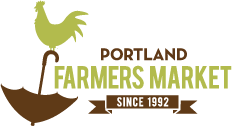Oregon Farmers Cut Out the Middle Man
by Bruce Pokarney, Oregon Department of Agriculture
Whether it is selling at farmers’ markets and roadside stands or marketing through community supported agriculture (CSAs), Oregon producers are more likely than their counterparts in other states to cut out the middle man. The latest Census of Agriculture shows Oregon farmers and ranchers are among the nation’s leaders in farm direct marketing.
According to the Census of Agriculture, Oregon ranks sixth in the nation with 6,274 farms reporting direct sales of agricultural products to individual consumers. Only California, Texas, Pennsylvania, New York, and Ohio have more farms with direct sales. The value of sales by farm direct marketing in Oregon has eclipsed $44 million, ranking ninth in the nation. The numbers include sales from farmers’ markets, roadside stands, pick your own operations, door-to-door sales, and CSAs.
While the census does not tally the number of farms participating specifically in farmers’ markets or roadside stands, it does break out farms marketing products through CSAs where Oregon ranks 10th of all states with 391 farms.
The growers behind the numbers agree there are advantages to farm direct marketing. The middle man is eliminated, which gives the farmer a better profit margin. Other advantages of selling directly to customers include better price and getting the money sooner. For the consumer, it’s easy and satisfying to know that the product being offered directly from an Oregon farm and locally grown.
Board of Agriculture member Barbara Boyer co-founded the McMinnville Farmers’ Market. She isn’t surprised by Oregon’s high rankings in farm direct marketing.
“The consumer is getting more educated and I think they want to close the loop from when the produce leaves the field to when it makes it to their plate,” says Boyer. “There’s a comfort level with food purchased directly from the farmer. I think the consumer enjoys meeting the farmer and having that conversation. That experience is just as important as the purchase.”
When the McMinnville Farmers’ Market started in 2001, it had 600 shoppers. Today, that number exceeds 4,000.
Laura Masterson is another Board of Agriculture member not surprised at Oregon’s standing, especially given the increased interest by consumers wanting to know where their food comes from.
“The opportunities for people to buy direct, the growth has been exponential in farmers markets, CSAs, in all of those areas” says Masterson. “We’ve been reaching into new markets, reaching new people, reaching suburban audiences that didn’t have access before, and all that equals more opportunities for more farmers.”
A look at the census shows that CSAs generally follow the same pattern of distribution around the state. CSA subscribers pay at the start of the growing season for a share of the harvest to follow and receive weekly shares of vegetables and fruits. The arrangements are particularly popular in Oregon’s urban communities.
As an urban farmer operating the 47th Avenue Farm in Southeast Portland since 1994, Masterson has been supplying fresh local produce primarily through a community supported agriculture program. Initially having an intense interest in agriculture but no real experience or ties with agriculture, she thought a CSA was a good way to start small and try it out with no major capital outlay. The decision for her proved to be a good one.
“I love farming and would want to farm no matter what,” says Masterson. “But the weekly interaction with the CSA customer is a huge benefit to me. I’m able to visit, share recipes, and have my food appreciated by our customers– just having that direct, heartfelt and thoughtful interaction on a regular basis means so much.”
More farmers and more consumers in Oregon are seeing the value of the farm direct relationship.
__
Interested in joining a CSA? View this awesome map created by the City of Portland.
